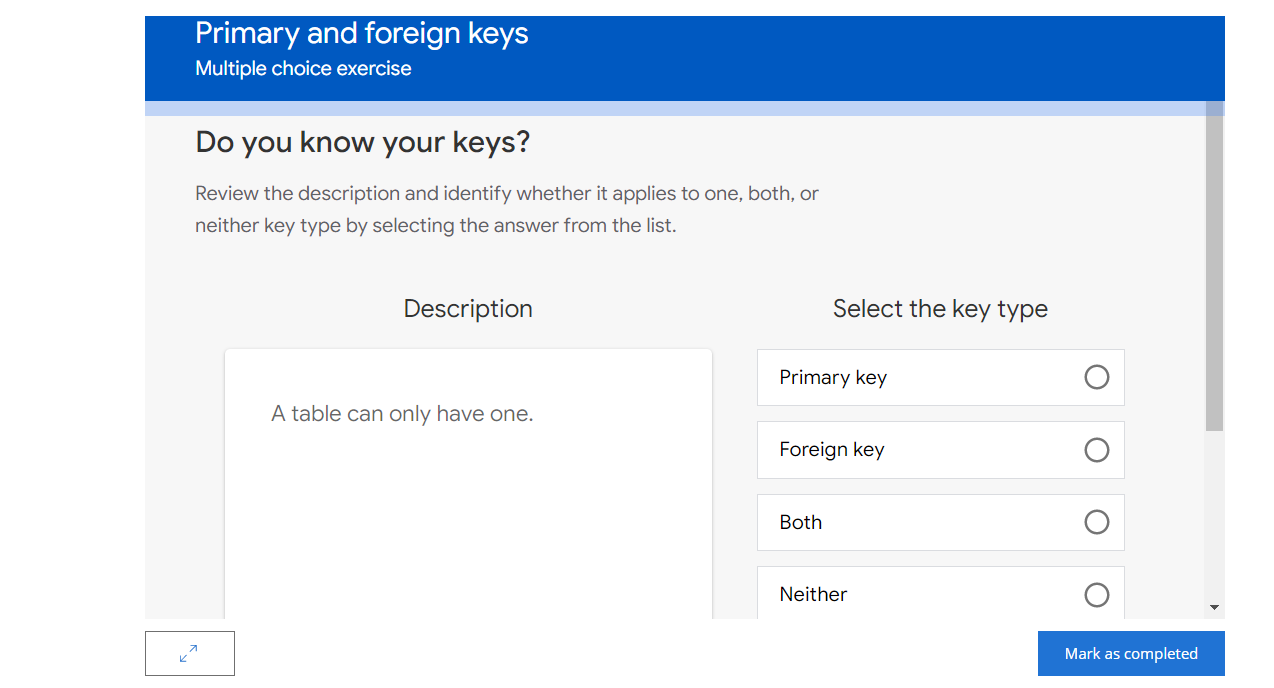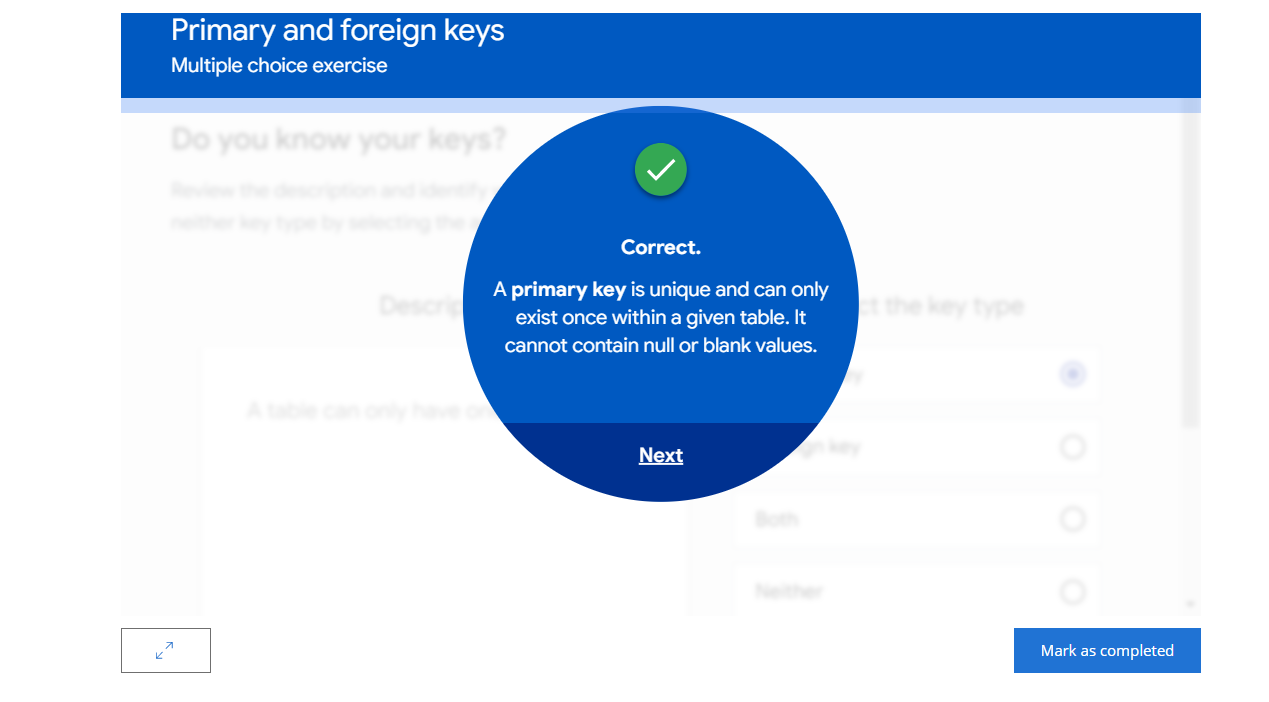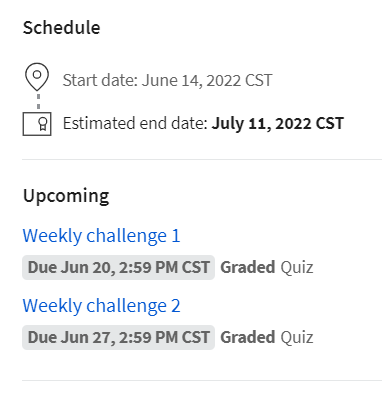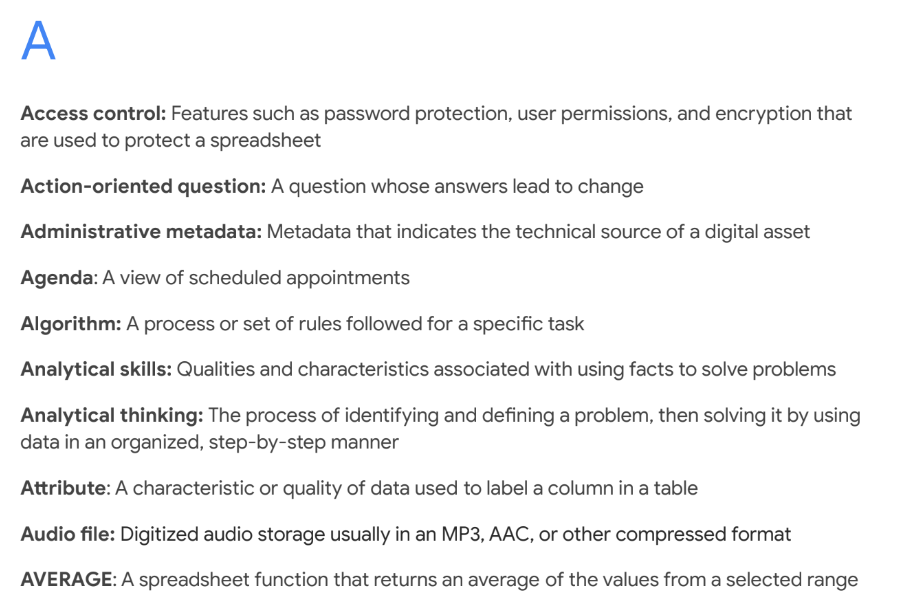Learning experience on the Google Data Analytics Course on Coursera (First Half)
2022-06-14
This post if about my personal feedback of Google Data Analytics Course from the 1st to 4th classes.
If you only have 2 minutes, you might want to jump directly to the next part: Is it worthly to take this Google Data Analytics Course. If you only want to know how Google proceed the course, you may jump to Google Data Analytics Course Introduction by clicking the link. Other personal review:Just My Thought。
Conclusion - Should I take this course:
(You may jump to each section by clicking each items below)
●Overall:5/5
(For those who have work experience but no data related experience )
● Flexibility:4/5
● Interactivity:5/5
● Difficulty:3/5
● Practical Benefit:?/5
● Price:4/5
Though I’ve only completed 4 out of the 8 classes so far, I’ve grown quite fond of this course. Even though the practical benefits of this certification for job hunting can’t yet be evaluated, the course itself holds substantial value and isn’t dry or tedious to follow. It’s an excellent introduction to data analysis. As many Google partners shared within this course: Everyone will use data analysis, not just those aiming for careers specifically in data analysis.
Beyond the expertise in data analysis, these 8 classes also interweave a lot of supplementary workplace knowledge. For example, it covers how to craft a data analyst resume, write formal emails, name files, identify key personnel in a company, and understand workflow processes. If you haven’t had much opportunity to learn how to process data using spreadsheets (Excel) in the past, this course allows you to build fundamental skills in one go. It can make you more efficient in handling data compared to others, helping you finish work earlier (and it’s practical for coordinating group orders of drinks and lunches too :P).
Highly recommended to click the Coursera-Google Data Analytics to start the trial for 7days free.
The 8 courses includes:
●Foundations: Data, Data, Everywhere
●Ask Questions to Make Data-Driven Decisions
●Prepare Data for Exploration
●Process Data from Dirty to Clean
●Analyze Data to Answer Questions
●Share Data Through the Art of Visualization
●Data Analysis with R Programming
●Google Data Analytics Capstone: Complete a Case Study
The course design also follows a clear logic. It starts with a foundational class and then progresses through five classes based on the data analysis process: Ask, Prepare, Process, Analyze, and Share. Additionally, there are supplementary classes covering the data analysis language R and a practical Case Study.
Upon completing all 8 classes, you can earn the Google Data Analytics Professional Certificate, which Google suggests can assist in seeking data analyst positions. I can’t personally assess this aspect, but judging from the course content alone, I believe it provides a strong professional reinforcement for my day-to-day tasks in business and market management.
If you got more time, here are more personal review about this course:
● Overall Score— 5/5
(For those who have work experience but no data related experience )
If you’re used to working with data in Excel as part of your regular job, although this course might not necessarily be exceptionally easy, it can be quite enjoyable. Even if you’ve only dealt with basic tasks such as handling order information, managing incoming and outgoing inventory, working with production and sales systems, managing employee attendance, maintaining student grade records, using CRM systems, navigating Google Analytics, and preparing financial reports… if you have some experience in tasks related to data, you’ll be able to quickly grasp the concepts in this course. The reason I personally like this course is that I feel the problems encountered in my work can be directly applied to the exercises, making the learning process very intuitive.
However, for complete beginners without work experience or prior exposure to analytical tools, although the course might not be too difficult to follow, even though Google explains concepts in a very gradual manner and provides numerous practice exercises, the absence of direct guidance (assignment feedback), coupled with the varying levels of student proficiency, means that the amount absorbed from the course and discussions largely depends on individual effort.
The course unavoidably carries a certain suspicion of promoting Google services, but given the reasonable cost of the course, I believe it’s worth exploring even if you’re just interested in listening in :)
●Flexibility— 4/5
You can totally schedule learning time on your own! The pre-set schedule is 10 hour per week but you can still speed up or postpone the courses base on your needs. The first part of cource includes Speed Track test. If you’re familiar the basic content, you may skip course 1 and 2 by passing the Diagnostic Quiz.
This is how Google explains the “Speed Track”:The Google Data Analytics Certificate is a program for anyone. A background in data analysis isn’t required. But you might be someone who has some experience already. If you are this type of learner, we have designed a speed track for this course. Learners who opt for the speed track can refresh on the basic topics and take each of the weekly challenges and the Course Challenge at a faster pace.
So this statement suggests that you have to get more than 80% of score to skip part of the courses.
One thing good to know is that even though you may skip some cources, you will still have to complete all the courses with 80% mark of grade for all the mandatory sections marked by start sign. This is the criteria to get the Google Data Analytics Professional Certificate。
I got 77.8% when I took the Speed Track test, while noticing Course 1, 2 are pretty basic for me. Nevertheless, I decided to continue the course 1, 2 to just refresh my memory.
●Interactivity— 5/5
Given that Google Data Analytics emphasizes “data analysis,” it’s evident that a lot of research and investigation went into crafting this entire course. I strongly suspect they employed significant psychological analysis in its development, as they integrated a game-like tactic to boost engagement: the progress bar! A progress bar is something that instigates the urge to fill it up, making you want to surge ahead now and then. This is why I managed to consistently tackle a bit of the course each day in the middle to later stages.
Furthermore, the course is designed with activity durations in mind. Almost every video is within 6 minutes, with most being between 2 to 4 minutes long. Even the longest technical tutorials are condensed into 12 minutes. It’s an utterly engaging duration; I can barely finish knitting a row before a section is completed, lol. Then, they promptly follow it up with a quiz, ensuring you’re not zoning out during those 2-4 minutes.
(I’m one of those people who somehow manage to pick the wrong answer right after listening to it. This directly validates their interactive approach, which is incredibly effective, especially for someone like me who tries to multitask.)
Additionally, each week’s curriculum is seamlessly interwoven with videos, exercises, practice problems, mini interactive games, ensuring you’re never bored.
Some example for the “little game”
●Difficulty— 3/5
This course isn’t an advanced course; many parts merely introduce concepts. Moreover, without a personal instructor, certain technical aspects like the SQL section I just completed don’t really allow us to get equipped to a higher level of knowledge. Even the Kaggle exercises only scratch the surface.
Furthermore, in this course, there isn’t anyone who can directly solve your technical problems. Although Google has employed clever methods to enhance this aspect, such as having a community discussion board for everyone to engage in discussions, and providing assignment templates (reference answers) to guide your practice, I personally feel that most of the time, it’s still up to your own prior experience. For certain assignments related to my job, I roughly knew how to modify my work after looking at the template. But when faced with technical issues, I had to discuss with friends who are familiar with the tools or seek resources from other websites.
However, Google has undoubtedly taken this concern into consideration. Whenever they introduce concepts that can’t be delved deeper into during the course, they refer explanations from other websites, allowing you to explore further on your own. I find this to be a commendable approach, particularly for beginners who might not even know what keywords to search for to find supplementary reading materials. It’s a bit like the references university professors provide for you to read.
For example, The microsoft post is introduced in the clean data section: Top10 ways to clean your data
●Practical Benefit— ?/5
From a job-seeking perspective, I find it quite challenging to assess the practicality of this certification. The reason being that this course is still quite new, and in Taiwan, many industries or job roles might not yet understand the significance of a data analyst, or they might have analysts but aren’t sure how to utilize them effectively. In publicly available job listings, roles that emphasize technical development (such as creating KPI report dashboards and predictive models) still largely revolve around Data Scientists or Data Engineers in the IT field. Despite Google stating in this course that around 60% of data analysts primarily use spreadsheets in their work, if you intend to progress towards a career in data analysis after completing this course, further refinement of tool expertise might still be necessary.
Reference: A Hiring Manager’s review of the Google Data Analytics Professional Certificate syllabus:I think this is a valuable addition to the ecosystem and has the potential to be a good onramp for many people to enter the industry. The cost is by no means negligible for many people, but I think at $39/m provides fantastic value just considering the breadth of topics this covers.
However, when it comes to market management and business-related roles, I believe the practicality can reach a 4 or even higher. Learning to utilize tools often created by colleagues in engineering roles within a company should enhance communication in the future. It can also simplify the process of analyzing relatively straightforward issues using online tools when venturing into new markets.
●Price— 4/5
This course provide free trial for 7days and the monthly subscription fee is $39 (Increased to $45 now). The true is you can adjust your own schedule to finish it earlier to reduce the total cost. If you follow Google’s pre-set schedule to complete the whole 8 course, the total cost would be $45/month* 6 = $270. Not too bad! (Almost equal to one admission fee of IELTS exam)
Google Data Analytics Course Introduction
Content
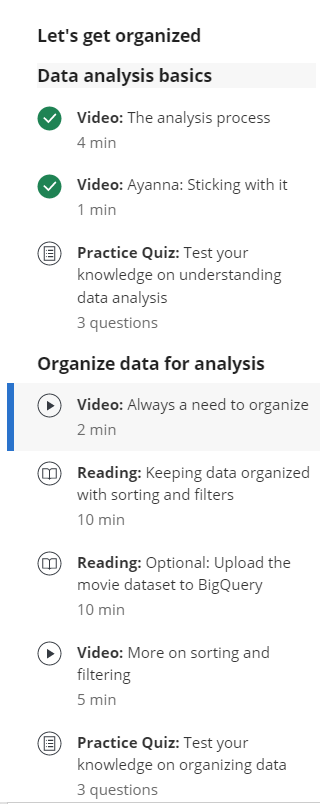
As mentioned above, Google has designed a progress bar. At the beginning of the course, you can review the course outline, and after completing each course activity, a checkmark will appear. Each subsection includes a small exercise. Failing an exercise might not necessarily affect the subsequent course section, but it can influence your assessment scores. Furthermore, even if you only miss one of the course exercise, the certificate for that particular course will not be issued.
The course is organized on a weekly basis, and the content of videos and assignments varies each week. Both videos and readings can be accessed through Coursera’s app, although I personally prefer using my laptop for note-taking, finding it more convenient. I primarily use the app for revisiting some contents during my commute.
Additionally, although there’s no strict timeframe for course completion, Google generally expects students to finish the course within a certain time frame. When you register for a course, it will estimate the time by which you should complete it.
For example, I’m currently on the 5th course, and upon registering today, it informed me that I should complete it by July 11th. Furthermore, the exercises also have due dates.
Learning Log
At the beginning, I was also reluctant to write the Learning Log’s Reflections because this part is similar to a case study. Most of the time, it requires inventing an issue on your own, which can be time-consuming and not necessarily easy to find a relevant case. Some prompts also ask how you plan to apply the acquired skills in the future. In my previous learning experiences, I wasn’t familiar to these reflective exercises. However, around the time I reached the second section, I realized that this part is actually quite valuable. For example, consider the following prompts:
Subsequently, this course will repeatedly have you utilize the response you’ve written, continuing to elaborate or prompting you to recall your thought process. If you’ve thoroughly considered the initial question, the subsequent learning will become much easier. Moreover, you can incorporate the challenges you face at work into this process, assessing whether this course can truly assist in your job and further determining if it’s beneficial to continue or not. Acquiring the certificate is by no means the most critical factor; evaluating the usefulness of the course for yourself and establishing an early stopping point is equally important.
Weekly Glossary
Another thoughtful aspect of this course is that it provides a Glossary of terms used in the course every week. This is not only beneficial for completing exercises but also proves handy for future reference in your work. Additionally, I’ve taken the initiative to create some notes based on the course outline, and after writing them down once, I generally remember the content.
Just My Thought
Learning data analysis through one of the world’s largest data companies, Google, offers distinct advantages, including access to their internal resources and insights from their employees. In one of the sessions focusing on “Dirty Data,” a Google engineer was invited to share her experiences in cleaning data. She mentioned that her favorite part was treating dirty data like a mystery, and herself as a detective unraveling it. Her lighthearted perspective gives you a glimpse into the intriguing nature of the work. Moreover, this course allows you to choose when to start and finish, offering a flexible career development option that doesn’t feel like committing to a university major indefinitely.
For my career goal of becoming a Senior Business and Product Manager, the practicality of this course rates at least a 4.
It teaches you how to read, organize data, and provides a useful foundation in SQL. However, more advanced techniques like data structuring or programming content for Data Engineers, which the course doesn’t cover, might not be of interest to everyone. The flexibility to choose when to stop after obtaining the certificate is a notable feature.
While browsing online, I’ve come across some reviews mentioning that the Google Data Analytics course appears to be water-down and that the exercises are relatively easy, allowing for a leisurely approach. In reality, the course involves numerous exercises that require achieving a score of over 80% to pass. There are probably ways to cut corners or even resort to cheating, given the popularity of the course. Simply copying the questions and searching on Google often leads to finding answers. This trend extends to the discussion part in this course as well. Even though written responses are required to complete certain tasks, it’s common to see other people merely copying and pasting the questions or providing minimal responses like “Done” or “…” to get by. As a result, encountering descriptions that suggest this course is easy and a surefire way to obtain certification can be a bit perplexing for me. The reason is that I feel even individuals with a background in data analysis might need to invest some time to complete assignments and practice operations on Google BigQuery, among other tasks for this course.
In my opinion, if this course is too easy or above surface for a person, it might be more worthwhile to accelerate the learning pace using the Speed Track option to skip some courses or perhaps consider not pursuing the certification at all.
At the end of the day, if the course appears overly simplistic, it’s reasonable to assume that those with a background in data analysis might not find the certification to carry significant weight. On the other hand, if the course becomes excessively challenging, obtaining the certification through a wrong learning attitude may hinder the practical application of the acquired knowledge, making it questionable to invest 3 months of time in such an endeavor.
In Courses 1 to 4, I personally favor the more technical content. While most lessons are engaging, SQL exercises stand out. Given my past experience with data cleaning and Excel, this part’s practical nature was particularly satisfying. Learning to write queries and manipulate data systematically was rewarding, and I look forward to further practice with real data.
Currently, I’m embarking on Course 5, and in two months, I hope to complete Courses 5 to 8. Feel free to join me on this journey as fellow learners!
My review for the second part of Google Analytic Course here:LEARNING EXPERIENCE ON THE GOOGLE DATA ANALYTICS COURSE ON COURSERA (SECOND HALF)

